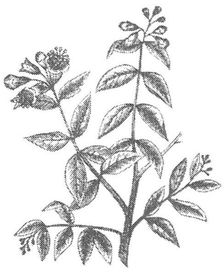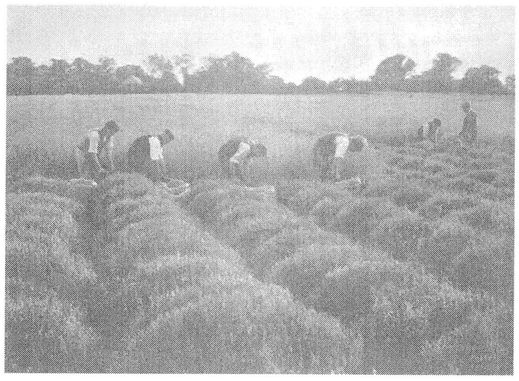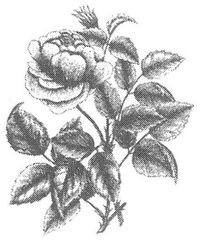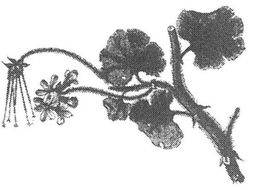Essence and Alchemy (14 page)
Read Essence and Alchemy Online
Authors: Mandy Aftel
Learning to combine the precious flower essences in a perfume composition is a direct experience of all the levels of meaning bound up in the integration of opposites. Working with such intense and polarized elements is exhilarating and scary, with the potential either to create something unique and beautiful in the right synthesis of matter and spirit or to destroy it altogether.
The heart notes lend themselves to being grouped in the following ways:
Â
Light
heart notes are florals that have a buoyant and airy quality, such as linden blossom, magnolia, and neroli.
heart notes are florals that have a buoyant and airy quality, such as linden blossom, magnolia, and neroli.
Neroli
is an essential oil that is water-distilled from the flowers of the bitter orange tree, which was introduced to the Mediterranean by the conquering Arabs in the tenth and eleven centuries. In fact, for the next five centuries the bitter orange was the only orange known to Europeans. The name neroli has been attributed to a princess of Neroli, a member of the distinguished Italian Orsini family, who introduced it to the courts of Europe toward the close of the seventeenth century.
is an essential oil that is water-distilled from the flowers of the bitter orange tree, which was introduced to the Mediterranean by the conquering Arabs in the tenth and eleven centuries. In fact, for the next five centuries the bitter orange was the only orange known to Europeans. The name neroli has been attributed to a princess of Neroli, a member of the distinguished Italian Orsini family, who introduced it to the courts of Europe toward the close of the seventeenth century.
The flowers require delicate handling. To obtain the highest
quality oil, they must be picked on a warm, sunny day when the blossoms are just beginning to open; closed buds render an inferior oil with a somewhat “green” odor, while flowers open too far are apt to fade and spoil during transportation and storage. They must be distilled quickly, before incipient decay introduces unpleasant off-notes. The essence itself should be kept in the refrigerator in a dark bottle, or it will lose its freshness very quickly.
quality oil, they must be picked on a warm, sunny day when the blossoms are just beginning to open; closed buds render an inferior oil with a somewhat “green” odor, while flowers open too far are apt to fade and spoil during transportation and storage. They must be distilled quickly, before incipient decay introduces unpleasant off-notes. The essence itself should be kept in the refrigerator in a dark bottle, or it will lose its freshness very quickly.
With its fresh, citrusy scent, neroli was historically used in cologne mixtures. It is easily overwhelmed by an intense base chord and should be used where its light, dry nature can shine. It has high odor strength and blends well with all the citruses and all the florals.
Â
Spicy
fragrances include actual spices as well as florals that possess sharp, spicy notes; they simultaneously stimulate the sense of smell and the sense of taste. They include allspice, ginger absolute, black pepper absolute, clove absolute, and kewda, a large Indian flower that smells like a combination of pepper and tuberose.
fragrances include actual spices as well as florals that possess sharp, spicy notes; they simultaneously stimulate the sense of smell and the sense of taste. They include allspice, ginger absolute, black pepper absolute, clove absolute, and kewda, a large Indian flower that smells like a combination of pepper and tuberose.
Cleve
derives its name from the French
clou
, in an allusion to the clove bud's nail-like shape. It grows on a tree that may have originated in tropical Asia, perhaps in the Moluccas, where early Portuguese explorers encountered it. It became an important part of the spice trade and the accompanying sea battles among the Portuguese, Spanish, Dutch, French, and English.
derives its name from the French
clou
, in an allusion to the clove bud's nail-like shape. It grows on a tree that may have originated in tropical Asia, perhaps in the Moluccas, where early Portuguese explorers encountered it. It became an important part of the spice trade and the accompanying sea battles among the Portuguese, Spanish, Dutch, French, and English.
Clove

Every part of the clove tree contains the aromatic essential oil, but its greatest concentration is in the bud, which is dried and crushed to render the essence. Clove bud oil moves from a fresh, fruity, spicy note to a warm, woody, spicy one. It can be
combined with vanilla to produce a “carnation” note, and it is a frequent constituent of “Oriental” blends. Combined with rose, ylang ylang, and other sweet florals, it produces a unique note of natural richness and body. It can be used, in small doses, in almost any perfume.
combined with vanilla to produce a “carnation” note, and it is a frequent constituent of “Oriental” blends. Combined with rose, ylang ylang, and other sweet florals, it produces a unique note of natural richness and body. It can be used, in small doses, in almost any perfume.
Cinnamon
has an ancient history, picturesquely recounted by Ernest Guenther: “Flotillas of sturdy vessels
74
, their sails bulging in the steady monsoon winds, winged their way across the Indian Ocean's blue billows and along Arabia's barren shores toward Egypt, where the precious spice could by conveyed to sharp-faced dealers from Phoenicia who supplied the Greek and Roman trade. Or the spice was carried on camel back across Mesopotamia's timeless caravan trails, now buried in sand and forgotten, from the Persian Gulf to Babylon, and finally to Sidon and Tyre on the Mediterranean.”
has an ancient history, picturesquely recounted by Ernest Guenther: “Flotillas of sturdy vessels
74
, their sails bulging in the steady monsoon winds, winged their way across the Indian Ocean's blue billows and along Arabia's barren shores toward Egypt, where the precious spice could by conveyed to sharp-faced dealers from Phoenicia who supplied the Greek and Roman trade. Or the spice was carried on camel back across Mesopotamia's timeless caravan trails, now buried in sand and forgotten, from the Persian Gulf to Babylon, and finally to Sidon and Tyre on the Mediterranean.”
The cinnamon tree yields essential oils from its leaves, bark, and root, each differing in composition and value. The most valuable comes from the bark. It is of a golden color when fresh and becomes red with age. Cinnamon possesses a powerful, warm, spicy, sweet character, both diffusive and tenacious. Its top note is very fresh, fruity, and candylike, followed at some distance by a dry, dusty, powdery dryout note. Because of its intensity, it should be used very sparingly, and its strong association with baked goods and potpourri is a challenge to the ingenuity of the perfumer.
Cinnamon

Green
essences recall the smells of spring: freshly cut grass and dewy leaves. They include clary sage, lavender absolute, lovage, and violet leaf
essences recall the smells of spring: freshly cut grass and dewy leaves. They include clary sage, lavender absolute, lovage, and violet leaf
Lavender absolute
, from the flowers and stalks of the lavender plant, is a beautiful dark green liquid with a pronounced herbaceous odor
that dries down to a woody, spicy pungency like that of the flowering herb itself. It is a much more interesting substance than the ubiquitous lavender oil, which by comparison seems thin and astringent. It is particularly useful when you want a more full-bodied lavender odor in the middle of a perfume, perhaps to lend an herbal note to a flowery middle chord. As a bonus, it lends a lovely hue to the finished perfume. It blends well with labdanum, patchouli, vetiver, pine needle, and clary sage.
, from the flowers and stalks of the lavender plant, is a beautiful dark green liquid with a pronounced herbaceous odor
that dries down to a woody, spicy pungency like that of the flowering herb itself. It is a much more interesting substance than the ubiquitous lavender oil, which by comparison seems thin and astringent. It is particularly useful when you want a more full-bodied lavender odor in the middle of a perfume, perhaps to lend an herbal note to a flowery middle chord. As a bonus, it lends a lovely hue to the finished perfume. It blends well with labdanum, patchouli, vetiver, pine needle, and clary sage.
Clary sage
was first employed commercially by German wine merchants as
Muskateller sallier
(muscatel sage) for its distinctive flavor, reminiscent of muscatel grapes. In the past century it has been cultivated in Italy's Piedmont district, the powdered flowers being used in the manufacture of vermouth. Its name derives from the Latin
clarus
, meaning clear, and it was commonly known as “clear eye
75
” for its function in a decoction used to cleanse the eye of foreign bodies. The green parts of the plant, especially the flowering tops, contain an essential oil with a delightful, somewhat winelike odor that is said to be reminiscent of ambergris.
was first employed commercially by German wine merchants as
Muskateller sallier
(muscatel sage) for its distinctive flavor, reminiscent of muscatel grapes. In the past century it has been cultivated in Italy's Piedmont district, the powdered flowers being used in the manufacture of vermouth. Its name derives from the Latin
clarus
, meaning clear, and it was commonly known as “clear eye
75
” for its function in a decoction used to cleanse the eye of foreign bodies. The green parts of the plant, especially the flowering tops, contain an essential oil with a delightful, somewhat winelike odor that is said to be reminiscent of ambergris.
Reaping English lavender

Clary sage has a sweet, ambery, herbaceous top note that progresses to a warm, balsamic dryout note. It imparts a mellowness, sweetness, and persistence to almost any perfume blend and marries especially well with labdanum, coriander, cardamom, geranium, lavender, cedarwood, and sandalwood. It is the sweetheart of aromatherapy oils for its calming, revitalizing, and balancing properties.
Â
Rosy
scents are a self-evident group. They include rose geranium, geranium, rose concrete, rose absolute, and rose attar.
scents are a self-evident group. They include rose geranium, geranium, rose concrete, rose absolute, and rose attar.
Rose
is the ultimate heart note. As Colette effused, “All is permitted
76
the roseâsplendor, a conspiracy of perfumes, petalous flesh that tempts the nose, the lips, the teeth ⦠And all is said, all is born in the year the moment it arrives; the first rose merely heralds all other roses. How confident it is, and how easy to love! It is riper than fruit, more sensual than cheek or breast.”
is the ultimate heart note. As Colette effused, “All is permitted
76
the roseâsplendor, a conspiracy of perfumes, petalous flesh that tempts the nose, the lips, the teeth ⦠And all is said, all is born in the year the moment it arrives; the first rose merely heralds all other roses. How confident it is, and how easy to love! It is riper than fruit, more sensual than cheek or breast.”
As noted, roses and their essences possess infinite variation. Just as there are avid gardeners who can distinguish many varieties of rose in the dark, an experienced perfumer can differentiate among rose absolutes from India, Egypt, Morocco, France, Bulgaria, and Russia. It has even been noted that the roses on a given bush smell different at different times of day, and that the intensity of the scent increases before a storm. Therefore, the blossoms are gathered before they open, a little before sunrise. Were they gathered later in the day, in full flower, the perfume would be stronger but not so sweet.
Rose

Rose absolute, like jasmine, mixes
well with any other oil. It forgives all indiscretions and brings out the best in the other notes with its full-bodied, unthreatening beauty. If you have made a mistake in your blending, sometimes adding a bit more rose will remedy the problem. My favorite of all the rose absolutes is currently Moroccan rose, with its complex but soft and sweet scent. Rose concrete, which has a softer, less powerful character, can be used in conjunction with the absolute to extend the rose note more economically.
well with any other oil. It forgives all indiscretions and brings out the best in the other notes with its full-bodied, unthreatening beauty. If you have made a mistake in your blending, sometimes adding a bit more rose will remedy the problem. My favorite of all the rose absolutes is currently Moroccan rose, with its complex but soft and sweet scent. Rose concrete, which has a softer, less powerful character, can be used in conjunction with the absolute to extend the rose note more economically.
Needless to say, rose is an aphrodisiac. It is also felt to drive away melancholy and lift the heart.
Geranium
is distilled from the leaves and stems of the plant. The best geranium is known as geranium Bourbon and comes from the tiny island of La Reunion (formerly called Bourbon), near Madagascar. This potent greenish-colored oil has a rosy and minty top note that fades to a rich, long-lasting, sweet-rosy dryout. It is lighter than some of the white-flowered middle notes and can lend a rosy tone that does not dominate a blend. I find it rather boring and don't use it much, but it does work well with other florals, especially the various rose absolutes, and can extend their scent without overextending your pocketbook. It also blends well with bergamot, patchouli, clove, lime, and sandalwood. Geranium is considered to be a pick-me-up for general fatigue and helps to reduce stress.
is distilled from the leaves and stems of the plant. The best geranium is known as geranium Bourbon and comes from the tiny island of La Reunion (formerly called Bourbon), near Madagascar. This potent greenish-colored oil has a rosy and minty top note that fades to a rich, long-lasting, sweet-rosy dryout. It is lighter than some of the white-flowered middle notes and can lend a rosy tone that does not dominate a blend. I find it rather boring and don't use it much, but it does work well with other florals, especially the various rose absolutes, and can extend their scent without overextending your pocketbook. It also blends well with bergamot, patchouli, clove, lime, and sandalwood. Geranium is considered to be a pick-me-up for general fatigue and helps to reduce stress.
Geranium

Other books
The Coachman's Daughter by Gayle Eden
Only His by Susan Mallery
Happily Ever Now (Boundless Love Book 2) by Iris Deorre
BlueBuried Muffins (Black Cat Cafe Cozy Mystery Series Book 1) by Lyndsey Cole
Awakening: The Deep Sleep (The Deep Sleep Trilogy Book 1) by Victoria Boyson
Skateboard Tough by Matt Christopher
Twice the Touch by Cara Dee
3 Hit the Road Jack by Christin Lovell
Cuba Libre (2008) by Leonard, Elmore